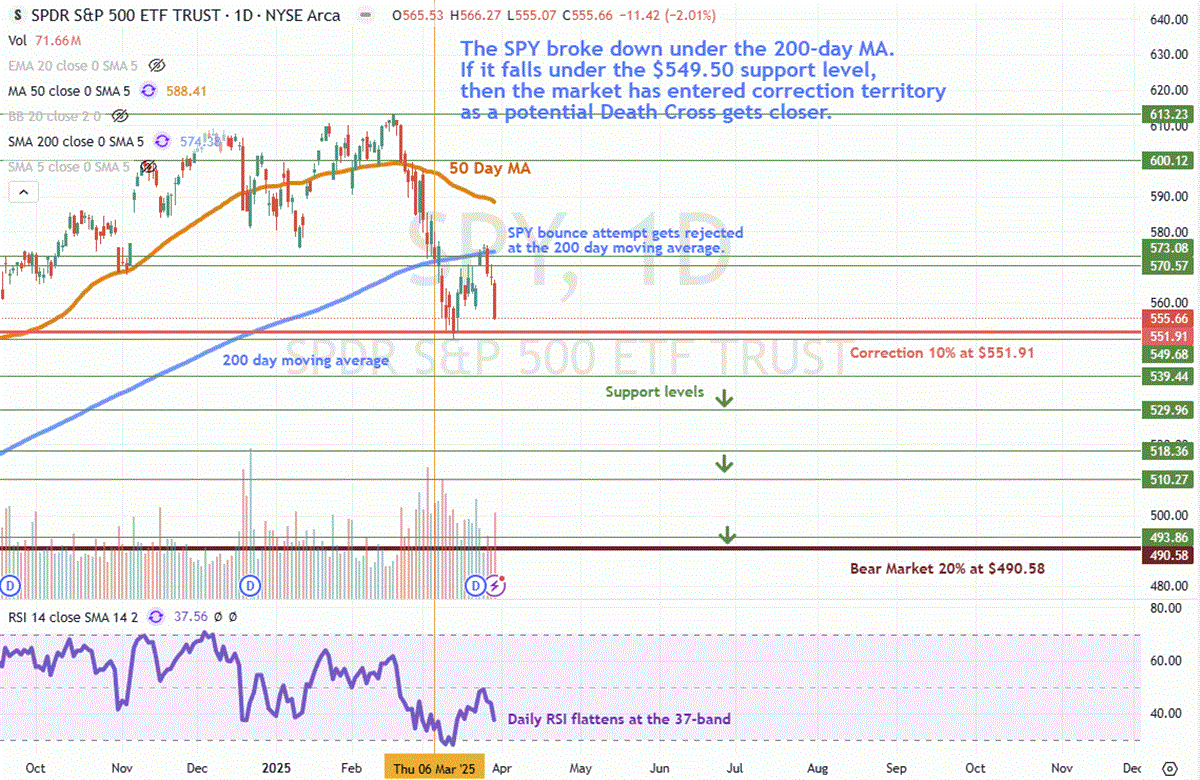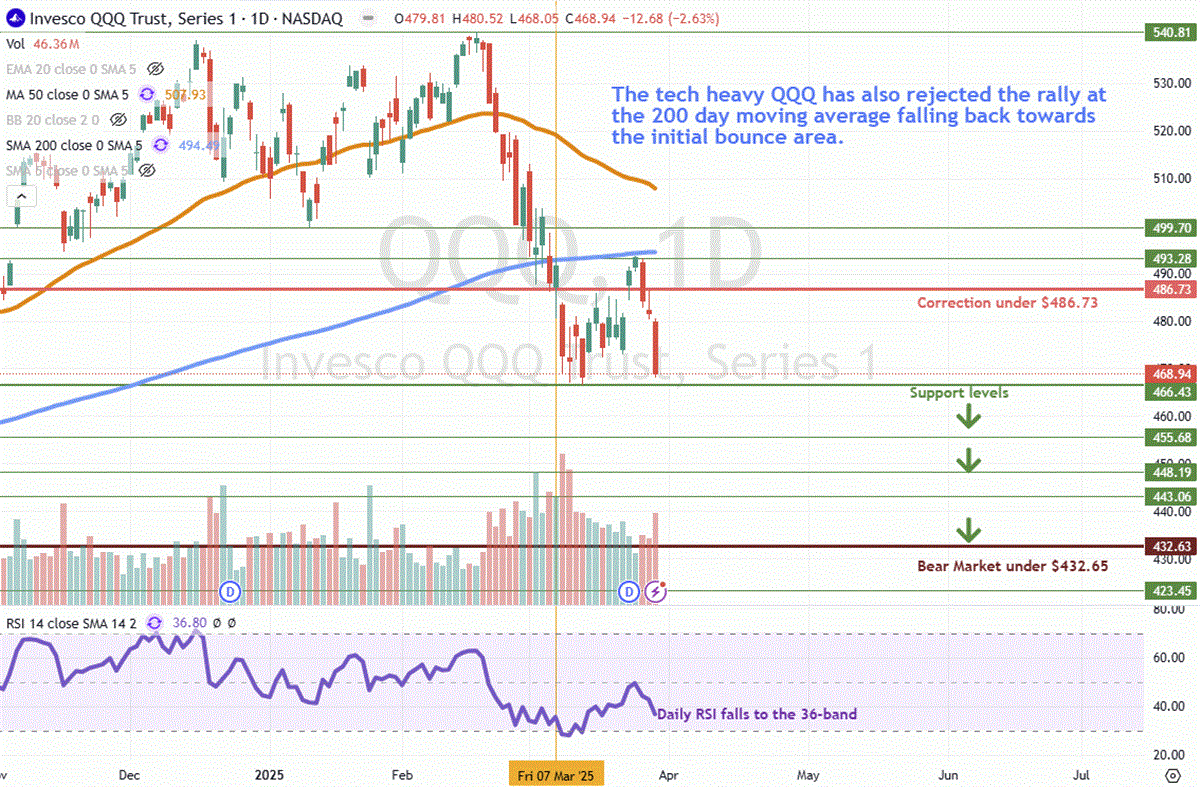SPDR S&P 500 ETF Trust Stock Forecast Today
12-Month Stock Price Forecast:$564.52Moderate BuyBased on 1238 Analyst Ratings | Current Price | $564.52 |
|---|
| High Forecast | $564.52 |
|---|
| Average Forecast | $564.52 |
|---|
| Low Forecast | $564.52 |
|---|
SPDR S&P 500 ETF Trust Stock Forecast DetailsThe SPDR S&P 500 ETF Trust NYSEARCA: SPY is trading down 5.19%, and the NASDAQ 100, as tracked by the Invesco QQQ NASDAQ: QQQ, is down 8.2% year-to-date (YTD) as of March 28, 2025. The markets attempted a relief rally that was rejected at the 200-day moving average on the SPY. A number of factors played into the sentiment reversal, causing investors to ponder whether the relief rally is taking a pause or is a complete head fake.
The computer and technology sector, tracked by the iShares U.S. Technology ETF NYSEARCA: IYW, has fallen into correction territory, down -11.8% YTD, also as of March 28, 2025. The 200-day moving average support levels have been rejected on both the SPY and QQQ.
Weak Economic Reports Underscoring the Recession Fears
The Conference Board’s Consumer Confidence Index fell by 7.2 points in March to 92.9. This is the fourth month in a row that it has declined. Recall that in February, the index fell 7% to 98.3, which was the largest drop since August 2021. March dropped even harder than February’s reading.
The Expectations index dropped 9.6 points to 65.2, the lowest level in 12 years, far below the 80 threshold that signals a recession ahead. The report is taken from consumers over 55 years old and, to a lesser extent, consumers between 35 to 55 years old.
Conference Board Senior Economist Stephanie Guichard commented, “Consumer confidence declined for a fourth consecutive month in March, falling below the relatively narrow range that had prevailed since 2022. Of the Index’s five components, only consumers’ assessment of present labor market conditions improved slightly. Views of current business conditions have weakened to close to neutral.
Consumers’ expectations were especially gloomy, with pessimism about future business conditions deepening and confidence about future employment prospects falling to a 12-year low.
Meanwhile, consumers’ optimism about future income—which had held up quite strongly in the past few months—largely vanished, suggesting worries about the economy and labor market have started to spread into consumers’ assessments of their personal situations.”
The Real-Time Recession Indicator from the Atlantic Fed’s GDPNow Falls
The Federal Reserve Bank of Atlanta’s widely followed GDP Now model, which is a real-time estimate of GDP growth, is forecasting the GDP will decline -2.8% after the auto tariffs were announced closing the week of March 28, 2025. If the prediction materializes in the negative, then it would be the first negative GDP quarter since November 2022.
However, Goldman Sachs rebuts the GDPNow forecast, noting that the surge in gold imports is distorting it. The Atlantic Fed acknowledged this and released a "gold-adjusted" version showing a reading of -0.4%.
The SPY Rally Rejected at the 200-day Moving Average
The initial sell-off on the SPY bounced off the 10% "correction level ."This is marked by a 10% pullback from the highs, which is $551.91. The SPY fell just below there on March 13, 2025, and proceeded to rebound the following weeks, temporarily surging through the 200-day moving average to peak at $576.41 on March 26, before rejecting and falling sharply in the following days as Trump announced the 25% auto tariffs on all foreign cars and parts would go into effect on April 2. Trump also called April 2 “Liberation Day” when he would unveil details of reciprocal tariffs on foreign imports.

The rally was sharply rejected on the March 26 announcement. The 10% correction level at $551.91 is the key support level the SPY needs to hold. Should that level break, the next most significant area would be the 20% pullback area at $490.58, the dreaded “bear market” level.
A bear market occurs when the markets pull back 20% or more off their highs for 60 days or longer.
It’s also a potential recession trigger, so investors should be keenly aware of this price level should it test or break. At that point, it’s also important to be on the lookout for a Death Cross, which occurs when the 50-day moving average crosses below the 200-day moving average. While not all Death Crosses result in a recession, recessions can occur after a Death Cross forms in the following months.
The QQQ is Mirroring the SPY as it Also Rejected the 200 Day Moving Average
The QQQ initially fell under its 200-day moving average and collapsed through its 10% correction level at $486.73. The cliché, "The bigger they are, the harder they fall," holds as the collapse under the 200-day moving average didn't stop at the 10% correction level.
Invesco QQQ Today
$476.15 +3.45 (+0.73%) As of 04/2/2025 04:00 PM Eastern
- 52-Week Range
- $413.07
▼
$540.81 - Dividend Yield
- 0.63%
- Assets Under Management
- $297.55 billion
The QQQ bounced off $466.43 on March 13, bounced through the 10% correction level to peak just below the 200-day moving average and collapsed on March 26 simultaneously with the SPY, when Trump announced the 25% auto tariffs.

The QQQs are in much worse shape since they're already in correction territory. The dreaded bear market territory, which is a 20% pullback from the highs, is at $432.65.
Bulls will defend if the market falls to that area, but it's critical to hold because a death cross appears to be much closer on the QQQ than on the SPY.
Before you consider SPDR S&P 500 ETF Trust, you'll want to hear this.
MarketBeat keeps track of Wall Street's top-rated and best performing research analysts and the stocks they recommend to their clients on a daily basis. MarketBeat has identified the five stocks that top analysts are quietly whispering to their clients to buy now before the broader market catches on... and SPDR S&P 500 ETF Trust wasn't on the list.
While SPDR S&P 500 ETF Trust currently has a Hold rating among analysts, top-rated analysts believe these five stocks are better buys.
View The Five Stocks Here
MarketBeat has just released its list of 20 stocks that Wall Street analysts hate. These companies may appear to have good fundamentals, but top analysts smell something seriously rotten. Are any of these companies lurking around your portfolio?
Get This Free Report